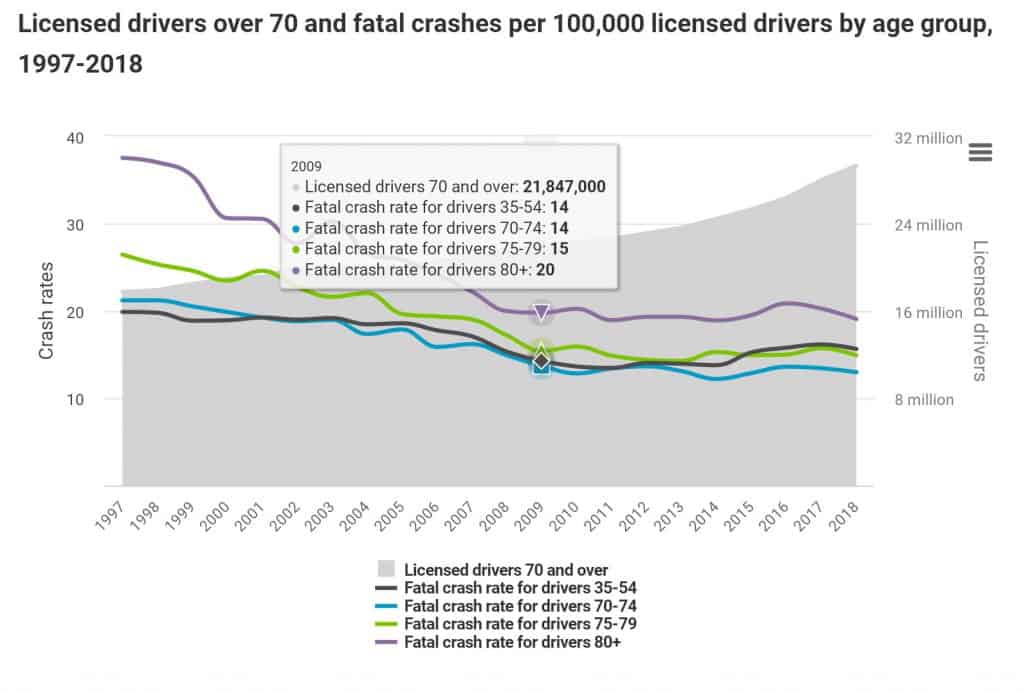Drivers in their 70s are now less likely to be involved in a fatal crash than those in their prime working years, a new study from the Insurance Institute for Highway Safety has found. That’s a remarkable reversal for a generation of drivers once thought to be an outsize threat to themselves and others on the road.
The number of older drivers has grown rapidly over the past two decades. But better health and safer vehicles, as well as possible benefits from infrastructure improvements and changes to licensing policies, have prevented an accompanying spike in crashes. Not only do drivers in their 70s now have fewer fatal crashes per licensed driver, but they also have fewer police-reported crashes per mile traveled than middle-aged drivers.
“Although efforts to address the ‘silver tsunami’ were largely ad hoc, in hindsight what we ended up with was a systems approach,” IIHS President David Harkey says. “And it worked.”
A systems approach examines the interconnected factors that contribute to a problem to develop a more holistic solution. Today, many highway safety advocates promote systems thinking to tackle a variety of road safety issues.
Historically, older drivers were more likely to crash than other age groups, and they were less likely to survive if they did crash. With the aging of the Baby Boom generation, a potential road safety crisis loomed on the horizon, the National Academies warned in 1988. A decade later, fatal crashes involving older drivers peaked at more than 4,800 in 1997.
For the new study, IIHS researchers compared trends among drivers 70 and over with drivers ages 35-54, looking at fatal crash involvements per 100,000 licensed drivers and per vehicle mile traveled, police-reported crash involvements per vehicle mile traveled, and the number of driver deaths per 1,000 police-reported crashes.
The number of older licensed drivers rose almost twice as fast from 2010 to 2018 as it had in the previous decade, while older drivers’ average annual mileage also continued to grow.
“Improvements in healthcare mean that older Americans are remaining active and staying in the workforce,” says Jessica Cicchino, IIHS vice president for research and a co-author of the study. “It follows that they’re not only keeping their licenses longer but also driving more miles.”
At the same time, improved health means older drivers are less likely to crash because the onset of problems like failing eyesight and impaired cognitive function is delayed. Seniors who are in better shape are also more likely to survive if they do crash.
Vehicles have gotten safer, too. The proportion of registered vehicles that earn good ratings in IIHS crash tests increases each year, and safety innovations like side airbags have been especially beneficial for older drivers.
Spurred in part by Federal Highway Administration training courses and a handbook of proven interventions launched in 1998, infrastructure changes designed to address common problems faced by older drivers, such as making traffic signs easier to see and converting intersections to roundabouts, may have had an impact as well.
For drivers 70 and over, fatal crash rates per licensed driver fell 43 percent from 1997 to 2018, compared with a decline of 21 percent for drivers ages 35-54. However, virtually all those reductions occurred during the first half of the study period. More recently, fatal crash involvements per driver remained steady for older drivers, while those of middle-aged drivers increased.
Per vehicle mile traveled, both fatal crashes and police-reported crashes of all severities rose substantially for middle-aged drivers in recent years and declined for drivers 70 and over. As a result, septuagenarians had fewer police-reported crashes per mile than middle-aged drivers for the first time in 2017.
“We’ve known for a long time that crash fatalities drop during recessions and rise with a strong economy,” says Cicchino. “These results suggest that this effect has been greater for middle-aged drivers than for drivers in their 70s.”
Other research suggests that speeding and alcohol-impaired driving also decrease during recessions and increase with economic growth. This might have widened the difference between older and middle-aged drivers, since olde
Looking at the number of driver deaths per 1,000 police-reported crashes, the researchers found substantial improvements for all but the oldest drivers between 2009 and 2017 following little change over the previous decade. During 2009-17, deaths per 1,000 police-reported crashes fell about 15 percent for drivers 35-54 and about 25 percent for drivers 70-79.
Though they’re healthier than ever, drivers 70 and over are still more fragile than younger people, so they’re more likely to die than middle-aged drivers if they do crash. The age of the vehicles they drive may be another factor.
“Older adults hold onto their vehicles longer, so it takes longer for them to reap the benefits of safety advancements,” Cicchino says. “That means we’re likely to see survival rates continue to improve as these advancements work their way into the U.S. fleet.”